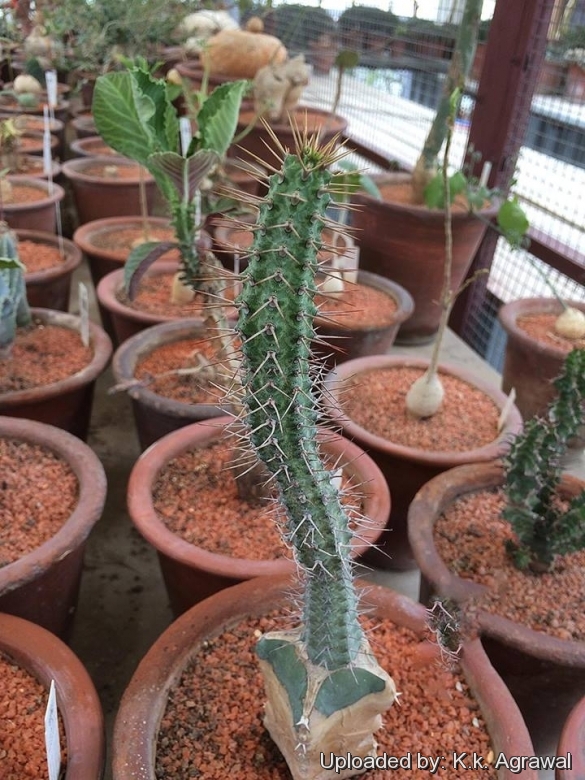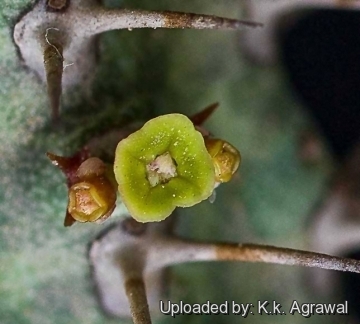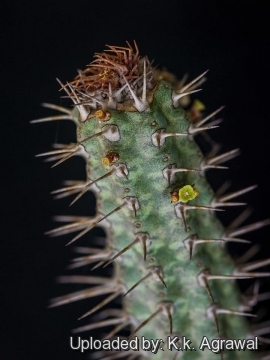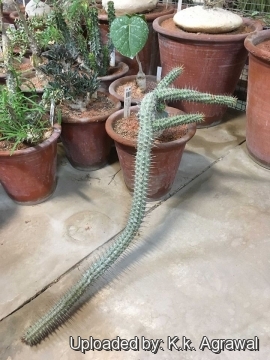




Your support is critical to our success.

Origin and Habitat: Ethiopia-Somalia border (near Webi Shebelli)
Type locality: Mustahil, Bale Region, Eeastern Ethiopia.
Altitude range: 180–300 metres above sea level.
Habitat and ecology: Rocky limestone slopes with open Acacia b
Synonyms:
- Euphorbia inaequispina N.E.Br.
Description: Euphorbia inaequispina is a dwarf and branching perennial succulent, leafless and very spiny. The cylindrical stems, crowded shields, and long unequal spines, readily distinguish this from all other known species except Euphorbia Ellenbeckii, from which it differs in the spine-shields not being 3-lobed, and an entire absence of a pair of prickles at the base of the spines.
Branches: Cylindrical, rarely rebranching, terete up to 30 cm long, 10-15 mm thick, tessellated with rounded tubercles 3–7 mm apart in about 7 slightly spiral series, covered with separate, crowded, roundish or obovate horny spine-shields, irregular in size on the same branch, 2–5 mm long, 1.5–2.5 mm wide, each bearing a pair of spines, at first brown, soon becoming pale grey.
Roots: Fibrous, with 5–15 tufted trailing branches which die off at the base but root to form new plants.
Spines: Very unequal, some pairs scarcely more than 1-3 mm long, others up to 18 mm long, all needle-like, straight, horizontally spreading, not very diverging. Prickles vestigial or apparently absent.
Leaves: Very rudimentary, minute.
Inflorescence (Cymes): Solitary, 1-forked, with peduncle and cyme-branches about 2 mm long.
Flowers (Cyathia): 2.5 mm in diameter; nectar-glands 1.5 mm broad, spreading, rectangular, reddish, more or less joined, orange. Styles 1.75 mm long.
Fruits (Capsules): Exserted on a recurved pedicel to 4 mm long, deeply and obtusely 3-lobed, 2 long, 2.7 mm in diameter, buff with a purple stripe along the sutures.
Seeds: Ovoid, 1.7 long, 1.3 mm broad, minutely and closely tuberculate, pinkish.
Bibliography: Major references and further lectures
1) J. G. Baker, with additions by C. H. Wright.”Flora of Tropical Africa”, Vol 6, 1913
2) S. Carter, M. G. Gilbert, and M. Thulin “Flora Somalia” Vol 1, 1993 [updated by M. Thulin 2008]
3) ʻAbdi ʻAbdulqadir Sheik-ʻAbdi “When a Hyena Laughs: A Somalian Novel” Dr. Leisure, 01 January 1994
4) Urs Eggli “Illustrated Handbook of Succulent Plants: Dicotyledons” Volume 2. Springer, 2002

Euphorbia inaequispina Photo by: K.k. Agrawal

Euphorbia inaequispina Photo by: K.k. Agrawal

Euphorbia inaequispina Photo by: K.k. Agrawal

Euphorbia inaequispina Photo by: K.k. Agrawal
Cultivation and Propagation: This specie has the fame to be quite tricky to cultivate. A very very light and warm place in full sun is highly appreciated. It does best in a mineral soil, good drainage is essential. Water sparingly during the summer months and keep dry in winter. In the short growing season it likes ample water and in this period it grows rather quickly, though not for a long time. When not in growth it is killed right away, when given too much water. It is a slow growing long lived plant and once established, it will be content in its position and with its soil for years. It can tolerate moderate shade, and a plant that has been growing in shade should be slowly hardened off before placing it in full sun as the plant will be severely scorched if moved too suddenly from shade into sun.
Frost Tolerance: Tender, it needs frost protection. Recommended minimum temperature is 12 °C or even above.
Propagation: It is propagated from seed sown during spring or summer. Germination occurs within 3 weeks. Sowing seed of this self fertile species is the surest method of growing typical offspring and seedlings are in the first season relatively easy to grow. It can be reproduced by cuttings or grafting as well but often lateral branches fail to produce the characteristic thick main stem.
Grafting: The plants that are grafted on a more vigorous and easier stocks are easier to keep, grow faster and produce more flowers and seeds. The method of grafting euphorbias differs little from that of other succulents, except in one important aspect. The latex must be washed or sprayed off until hardly anything remains. After the latex flow has stopped, a further 1-2 mm slice can be taken from both surfaces without a new latex flow starting. Both scion and stock need to be at the start of the growing season. The stock should be cut as near as possible to the growing tip, as here the vascular bundles are dense and not yet woody and will feed the scion in the best possible way. Where possible stock and scion should be of similar diameter. The cut surfaces are held together with elastic bands in cross style, over the plant top and under the pot. The plants should be left in an airy and shady place for 7-10 days before the bands are removed.
Warning: As with all other Euphorbias when a plant get damaged it exudes a thick white milky sap known as latex. This latex is poisonous and particularly dangerous for the eyes, skin and mucous membranes. So pay extreme attention not to get any in your eyes or mouth. Cultivated plants must be handled carefully.
| Your Actions | |
|---|---|
| Back to Euphorbia index | |
| Back to Euphorbiaceae index | |
 |
Back to Succulents Encyclopedia index |
Privacy stantement - Terms and conditions - How to cite - About us - Feedback - Donate




